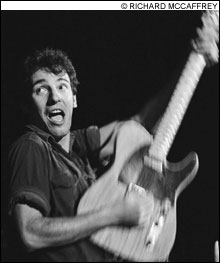
HE’S A ROCKER: Springsteen circa ’78 |
Rock and roll in black-and-white and in color comes to town this week, when Providence-based photographer Richard McCaffrey presents a show of his best work at the Dryden Gallery. McCaffrey has spent the last few months culling through his massive archives, which includes thousands of photographs of the very biggest names in the history of music, from which he will show 250 of the best moments in a grand space the size of a basketball court. McCaffrey was among the first handful of artists who managed to turn rock and roll into photographic art, a livelihood he has pursued in earnest since the early ’70s. The list of luminaries ranges from Led Zeppelin, the Who, and Bob Dylan to the Dead Kennedys, the Clash, and the Sex Pistols. McCaffrey, 63, took time from his job at Renaissance Creative Imaging, a commercial photographic and digital imaging business, to talk about his accomplishments and discuss the rapidly changing art of photography.What did you have to do to pull this showing together?
All my photos were on film, so it all had to be digitized, which took about six weeks. I had to sort through 3000 rolls of film, 100,000 images from the time period, which basically runs from 1973 to 1983. When I first started, I thought I’d get maybe 100 usable images out of it. But I found there were about 400 keepers, I whittled that down to 270 for the showing, and there will be 250 on the walls.
What kind of experience was it going through all your past work?
It was like looking at a diary. Plus, it’s much better than I thought it would be. I didn’t realize I photographed that many people. Of course, there were a lot of obscure, less-than-one-hit wonders.
Was there one shoot you remember over the others? Or a shot you saw that brought back a vivid memory?
Oh, yeah. I remember being backstage at the last Sex Pistols show at the Winterlands in San Francisco in 1978. There was a ruckus going on, a crowd of people, and I just held my camera in the air and took several pictures, without knowing what it was about. I thought it was a crowd of people partying. But after I developed them I saw that it was Sid Vicious in the middle of everyone causing quite a stir.
Can you talk about your beginnings in photography?
I’d say I was around 11 or 12 when I found a camera my parents used. It was a Kodak Brownie. When I was 14, I met another kid in my neighborhood who had a darkroom. So I learned how to develop and by 15 I had my own enlarger and darkroom in my bedroom.
I went into the Army at 18 in 1962, where I became an infantry machine gunner. I was stationed in Hawaii in 1964 and [became] an Army photographer. When I came back from the Army I got into the antiwar and alternative movements and ended up going back to school for photography in Boston.